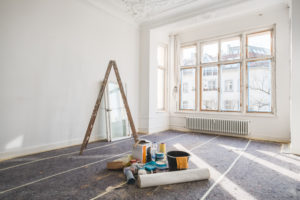
If you have a historic home that needs an update, you might find yourself wondering how to paint an old house. Historic homes are quirky – that’s why we love them. But they also take a little more work than new abodes. So, here are our pros’ top tips for painting over old interior paint.
Maintaining Your Home’s Charm When Painting Over Old Interior Paint
Maintaining the charm of your historic home means taking some extra time to prep before you paint. And that doesn’t mean just sanding* and taping – it also means researching historic paint colors that match your home’s period, to keep its architectural integrity.
You can start with searches on Pinterest and Instagram for historic home colors. While most paint companies have a historic paint line, an expert can help you pick the right vintage color scheme – including walls, trim and accents – for painting over old interior paint. After all, the color scheme you choose for a Victorian home is different than one you would choose for a midcentury modern space. Let our expert color consultants help with your color scheme.
Prepping Properly To Get the Best Results
As with any home, painting over old interior paint starts with the prep work. And older homes can take more prep than newer ones, considering the age and type of materials you’re working with. They may require more cleaning, patching or priming. And if your home has a popcorn ceiling, repainting is a good time to remove the popcorn and replace it with a smooth finish.
Your house may have some surprises in store for you where prepping is concerned, especially if your home has hidden damage, like mold, mildew or wood rot. And prepping plaster, for example, is a different process than prepping wallboard. So, this may be the time to call in a paint pro and have them assess your space before you break out the paint and rollers.
Depending on when your home was last painted, you may also have oil-based paint or lead paint. In most cases, pros recommending painting over oil-based paint with oil-based paint for the best results, but if you prefer water-based paint (as most of us do now), then your walls will need to be primed with a primer made for covering oil paint. And before you start prepping, have your home tested for lead* paint.
Using the Right Tools
Newer homes are a breeze to paint where tools are concerned – tarp, tape, rollers, brushes and a can of paint, and you’re good to go. But older homes may have a variety of wall surfaces, like plaster, paneling, block (cinder or glass) or brick. Each of these requires a different painting technique and could require a specific tool to get the best results.
And when painting over old interior paint, you’ll need to know which type of paint to use for each surface. For example, you might use high gloss on wood trim, but you probably wouldn’t on wood paneling or plaster, since glossy paint shows every imperfection in the wall.
Picking a Paint Pro
Painting over old interior paint comes with its own challenges – from choosing colors to using the right tools. If this seems like something you’d like a guide on, our interior paint pros can help. Get a free quote today.
*WARNING! If you scrape, sand, or remove old paint, you may release lead dust. LEAD IS TOXIC. EXPOSURE TO LEAD DUST CAN CAUSE SERIOUS ILLNESS, SUCH AS BRAIN DAMAGE, ESPECIALLY IN CHILDREN. PREGNANT WOMEN SHOULD ALSO AVOID EXPOSURE. Wear a NIOSH-approved respirator to control lead exposure. Clean up carefully with a HEPA vacuum and a wet mop. Before you start, find out how to protect yourself and your family by contacting the National Lead Information Hotline at 1-800-424-LEAD or log on to www.epa.gov/lead.